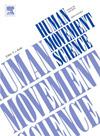Verbal arm swing instructions alter arm-leg interlimb coordination but not prefrontal cortex hemodynamics in people with Parkinson's disease
IF 1.9
3区 心理学
Q4 NEUROSCIENCES
引用次数: 0
Abstract
Verbal instructions related to the arm swing amplitude and velocity change step gait behavior in people with Parkinson's disease (PwPD) and neurotypical individuals. However, how verbal instructions related to upper limb act on interlimb coordination and prefrontal cortex activation are not yet known. Therefore, the aim of this study was to investigate the effects of the instructions to increase arm swing amplitude and velocity during walking on prefrontal cortex (PFC) hemodynamics and arm-leg interlimb coordination in PwPD and neurotypical individuals. Fifteen PwPD and 13 neurotypical individuals walked over a 26.8 m pathway under three experimental conditions: usual walking, walking with increased arm swing amplitude, and walking with increased arm swing velocity. Gait step parameters, continuous relative phase and latency between arm and leg movements, and PFC hemodynamics were calculated. ANOVA two-way (groups x conditions) showed that the verbal instructions to increase arm swing amplitude and velocity during walking improved gait step parameters and arm-leg interlimb coordination, without changing PFC hemodynamics. Specifically, verbal instructions increased average continuous relative phase (F2,52 = 45.5; p < 0.001; ηp2 = 0.63) and decreased the average relative phase variability (F2,52 = 86.9; p < 0.001; ηp2 = 0.77) in both groups and decreased PwPD latency (F2,52 = 3.5; p = 0.03; ηp2 = 0.19). Verbal instructions also increased stride length (F2,52 = 27.7; p < 0.001; ηp2 = 0.51) and velocity (F2,52 = 46.6; p < 0.001; ηp2 = 0.64) and decreased double support phase in both groups. These results allow us to speculate that the engagement of the motor areas to follow the instructions and perform the ensuing action could be related to preservation of some automaticity and it is possible that the participants do not need to use their cognitive resources by increasing PFC activity to process and do the action.
言语手臂摆动指示改变帕金森病患者的胳膊-腿间协调,但不改变前额叶皮层血流动力学
言语指示与帕金森病患者(PwPD)和神经正常个体的手臂摆动幅度和速度改变步步态行为有关。然而,与上肢相关的言语指令如何影响肢体间协调和前额叶皮层的激活尚不清楚。因此,本研究的目的是探讨行走中增加手臂摆动幅度和速度的指令对PwPD和神经典型个体前额叶皮质(PFC)血流动力学和四肢间协调的影响。15名PwPD个体和13名神经正常个体在正常行走、手臂摆动幅度增加行走和手臂摆动速度增加行走三种实验条件下行走26.8 m的路径。计算步态步长参数、连续相对相位和手臂和腿部运动之间的潜伏期以及PFC血流动力学。双因素方差分析(组x条件)显示,行走时增加手臂摆动幅度和速度的口头指示改善了步态步骤参数和胳膊-腿间协调,而不改变PFC血流动力学。具体而言,口头指示增加了平均连续相对相位(F2,52 = 45.5;p & lt;0.001;ηp2 = 0.63),降低了平均相对相变异性(F2,52 = 86.9;p & lt;0.001;ηp2 = 0.77), PwPD潜伏期降低(F2,52 = 3.5;p = 0.03;ηp2 = 0.19)。口头指示也增加步幅(F2,52 = 27.7;p & lt;0.001;ηp2 = 0.51)和流速(F2,52 = 46.6;p & lt;0.001;ηp2 = 0.64),双支持期减少。这些结果使我们推测,运动区参与遵循指示并执行随后的动作可能与保留一些自动性有关,并且有可能参与者不需要通过增加PFC活动来使用他们的认知资源来处理和执行动作。
本文章由计算机程序翻译,如有差异,请以英文原文为准。
求助全文
约1分钟内获得全文
求助全文
来源期刊

Human Movement Science
医学-神经科学
CiteScore
3.80
自引率
4.80%
发文量
89
审稿时长
42 days
期刊介绍:
Human Movement Science provides a medium for publishing disciplinary and multidisciplinary studies on human movement. It brings together psychological, biomechanical and neurophysiological research on the control, organization and learning of human movement, including the perceptual support of movement. The overarching goal of the journal is to publish articles that help advance theoretical understanding of the control and organization of human movement, as well as changes therein as a function of development, learning and rehabilitation. The nature of the research reported may vary from fundamental theoretical or empirical studies to more applied studies in the fields of, for example, sport, dance and rehabilitation with the proviso that all studies have a distinct theoretical bearing. Also, reviews and meta-studies advancing the understanding of human movement are welcome.
These aims and scope imply that purely descriptive studies are not acceptable, while methodological articles are only acceptable if the methodology in question opens up new vistas in understanding the control and organization of human movement. The same holds for articles on exercise physiology, which in general are not supported, unless they speak to the control and organization of human movement. In general, it is required that the theoretical message of articles published in Human Movement Science is, to a certain extent, innovative and not dismissible as just "more of the same."
 求助内容:
求助内容: 应助结果提醒方式:
应助结果提醒方式:


